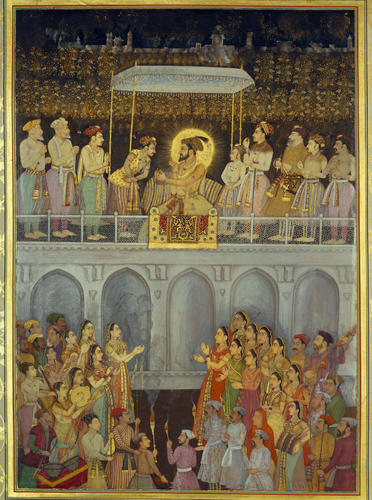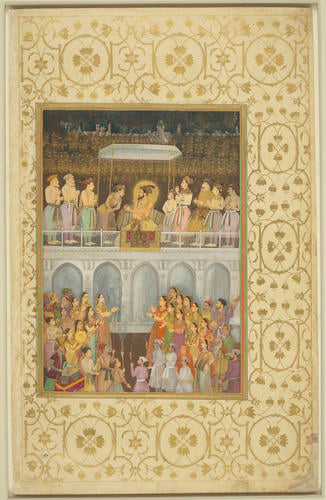-
1 of 253523 objects
Shah-Jahan honouring Prince Awrangzeb at his wedding (19 May 1637) c. 1640-50
Painting in opaque watercolour including metallic paints. | 33.7 x 23.5 cm (image) | RCIN 1005025.at

Attributed to Bhola
Master: Padshahnamah پادشاهنامه (The Book of Emperors) Item: Shah-Jahan honouring Prince Awrangzeb at his wedding (19 May 1637) c. 1640-50

Attributed to Bhola
Master: Padshahnamah پادشاهنامه (The Book of Emperors) Item: Shah-Jahan honouring Prince Awrangzeb at his wedding (19 May 1637) c. 1640-50

Attributed to Bhola
Master: Padshahnamah پادشاهنامه (The Book of Emperors) Item: Shah-Jahan honouring Prince Awrangzeb at his wedding (19 May 1637) c. 1640-50



-
Padshahnamah fol. 218v
(plate 45)
Prince Awrangzeb’s sihra-bandi ceremony at Agra on 18 May 1637.
Prince Awrangzeb returned from his posting as Governor of the Deccan in April 1637 to prepare for his wedding to Dilras Banu, the daughter of Mirza Rustam, one of Shah-Jahan’s courtiers and a great-nephew of Shah Tahmasp I of Iran. This painting depicts the prince’s sihra-bandi ceremony, a Hindu wedding tradition adopted by the Mughals whereby, on the eve of his marriage, a sihra (veil) was fastened around the groom’s forehead to protect him from the evil eye. Late at night on 18 May 1637, Awrangzeb bends low as Shah-Jahan holds a veil of pearls, rubies and emeralds for him to wear. The setting is a riverfront terrace of the Agra Fort overlooking the River Jumna. Shah-Jahan sits below a white nam-gira canopy embroidered with silver stars, a type of awning used by the Emperor when holding court at night. Standing in attendance are Awrangzeb’s three brothers and a select group of high-ranking nobles, all barefoot in such close proximity to the Emperor.
A large ensemble of mostly female musicians and singers provide the spirit of festivity below the terrace. These women are probably kanchani, members of a professional class of dancers and singers. According to Francois Bernier, a European visitor to Shah-Jahan’s court, ‘They were not indeed the prostitutes seen in bazaars, but those of a more private and respectable class, who attend the grand weddings […] for the purpose of singing and dancing. Most of the Kenchens are handsome and well-dressed and sing to perfection.’ Niccolao Manucci similarly explained, ‘This class is more esteemed than others, by reason of their great beauty […] Ordinarily the dancing women dance in the principal open places in the city, beginning at six o’clock in the evening and go on till nine, lighted by many torches, and from this dancing they earn a good deal of money.’
This painting is attributed to the artist Bhola. Apart from the one ascribed and three attributed paintings in the Padshahnamah, there are no other known works by him. Perhaps the most striking aspect of this painting is his depiction of the golden fireworks on the opposite bank of the river which form in the shape of trees. According to an eyewitness, ‘in detailing the diversity of fireworks that night which illuminated the surface of the earth, the foot of the reed-pen goes lame, and the arena of description is insufficient of scope’.
Bibliography:
Milo Beach and Ebba Koch, King of the world : the Padshahnama, an imperial Mughal manuscript from the Royal Library, Windsor Castle, 1996
Saqib Baburi, Beyond the Akbarnamah: Padshahnamahs and Official Regnal Chronography for Shah-Jahan Padshah (r. 1037/1628-1068/1658), 2010.Provenance
Illustration from a Padshahnamah manuscript formerly in the Mughal imperial library and acquired by Asaf al-Dawlah, Nawab of Awadh, c.1780-90; presented by Saadat Ali Khan, Nawab of Awadh, to George III via Lord Teignmouth in June 1799.
-
Creator(s)
Acquirer(s)
-
Medium and techniques
Painting in opaque watercolour including metallic paints.
Measurements
33.7 x 23.5 cm (image)
58.2 x 36.7 cm (page dimensions)
Category